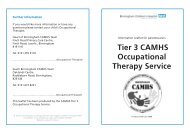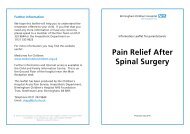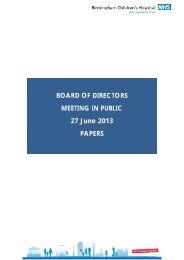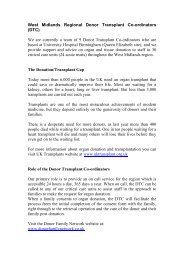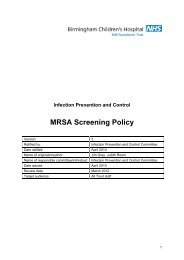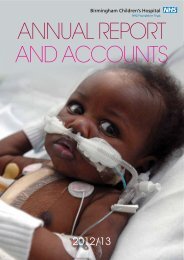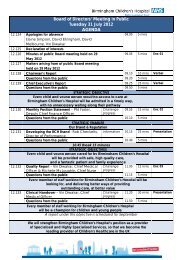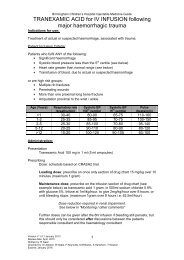ANNUAL ACCOUNTS 2009/10 - Birmingham Children's Hospital
ANNUAL ACCOUNTS 2009/10 - Birmingham Children's Hospital
ANNUAL ACCOUNTS 2009/10 - Birmingham Children's Hospital
- No tags were found...
Create successful ePaper yourself
Turn your PDF publications into a flip-book with our unique Google optimized e-Paper software.
<strong>Birmingham</strong> <strong>Children's</strong> <strong>Hospital</strong> NHS Foundation Trust - Statutory Accounts Year to 31 March 20<strong>10</strong>NOTES TO THE <strong>ACCOUNTS</strong>1.07 Donated Property, Plant and EquipmentDonated property, plant and equipment are capitalised at their fair value on receipt, with a matching credit to the donatedasset reserve. They are valued, depreciated and impaired as described above for purchased assets. Gains and losses onrevaluations and impairments are taken to the donated asset reserve and, each year, an amount equal to the depreciationcharge on the asset is released from the donated asset reserve to offset the expenditure. On sale of donated assets, the netbook value is transferred from the donated asset reserve to retained earnings.1.08 Non-current assets held for saleNon-current assets are classified as held for sale if their carrying amount will be recovered principally through a saletransaction rather than through continuing use. This condition is regarded as met when the sale is highly probable, theasset is available for immediate sale in its present condition and management is committed to the sale, which is expectedto qualify for recognition as a completed sale within one year from the date of classification. Non-current assets held forsale are measured at the lower of their previous carrying amount and fair value less costs to sell. Fair value is openmarket value including alternative uses.Deposits and other investments that are readily convertible into known amounts of cash at or close to theircarrying amounts are treated as liquid resources in the statement of cashflows.The profit or loss arising on disposal of an asset is the difference between the sale proceeds and the carrying amount andis recognised in the Statement of Comprehensive Income. On disposal, the balance for the asset on the revaluationreserve is transferred to retained earnings. For donated and government-granted assets, a transfer is made to or from therelevant reserve to the profit/loss on disposal account so that no profit or loss is recognised in income or expenses. Theremaining surplus or deficit in the donated asset or government grant reserve is then transferred to retained earnings.Property, plant and equipment that is to be scrapped or demolished does not qualify for recognition as held for sale.Instead, it is retained as an operational asset and its economic life is adjusted. The asset is de-recognised when it isscrapped or demolished.1.09 LeasesLeases are classified as finance leases when substantially all the risks and rewards of ownership are transferred to thelessee. All other leases are classified as operating leases.The Trust as lesseeProperty, plant and equipment held under finance leases are initially recognised, at the inception of the lease, at fair valueor, if lower, at the present value of the minimum lease payments, with a matching liability for the lease obligation to thelessor. Lease payments are apportioned between finance charges and reduction of the lease obligation so as to achieve aconstant rate on interest on the remaining balance of the liability. Finance charges are recognised in calculating theTrust‟s surplus/deficit.Operating lease payments are recognised as an expense on a straight-line basis over the lease term. Lease incentives arerecognised initially as a liability and subsequently as a reduction of rentals on a straight-line basis over the lease term.Contingent rentals are recognised as an expense in the period in which they are incurred.Where a lease is for land and buildings, the land and building components are separated. Leased land is treated as anoperating lease. Leased buildings are assessed as to whether they are operating or finance leases.The Trust as lessorAmounts due from lessees under finance leases are recorded as receivables at the amount of the Trust‟s net investment inthe leases. Finance lease income is allocated to accounting periods so as to reflect a constant periodic rate of return onthe Trust‟s net investment outstanding in respect of the leases.Rental income from operating leases is recognised on a straight-line basis over the term of the lease. Initial direct costsincurred in negotiating and arranging an operating lease are added to the carrying amount of the leased asset andrecognised on a straight-line basis over the lease term.Page 8





